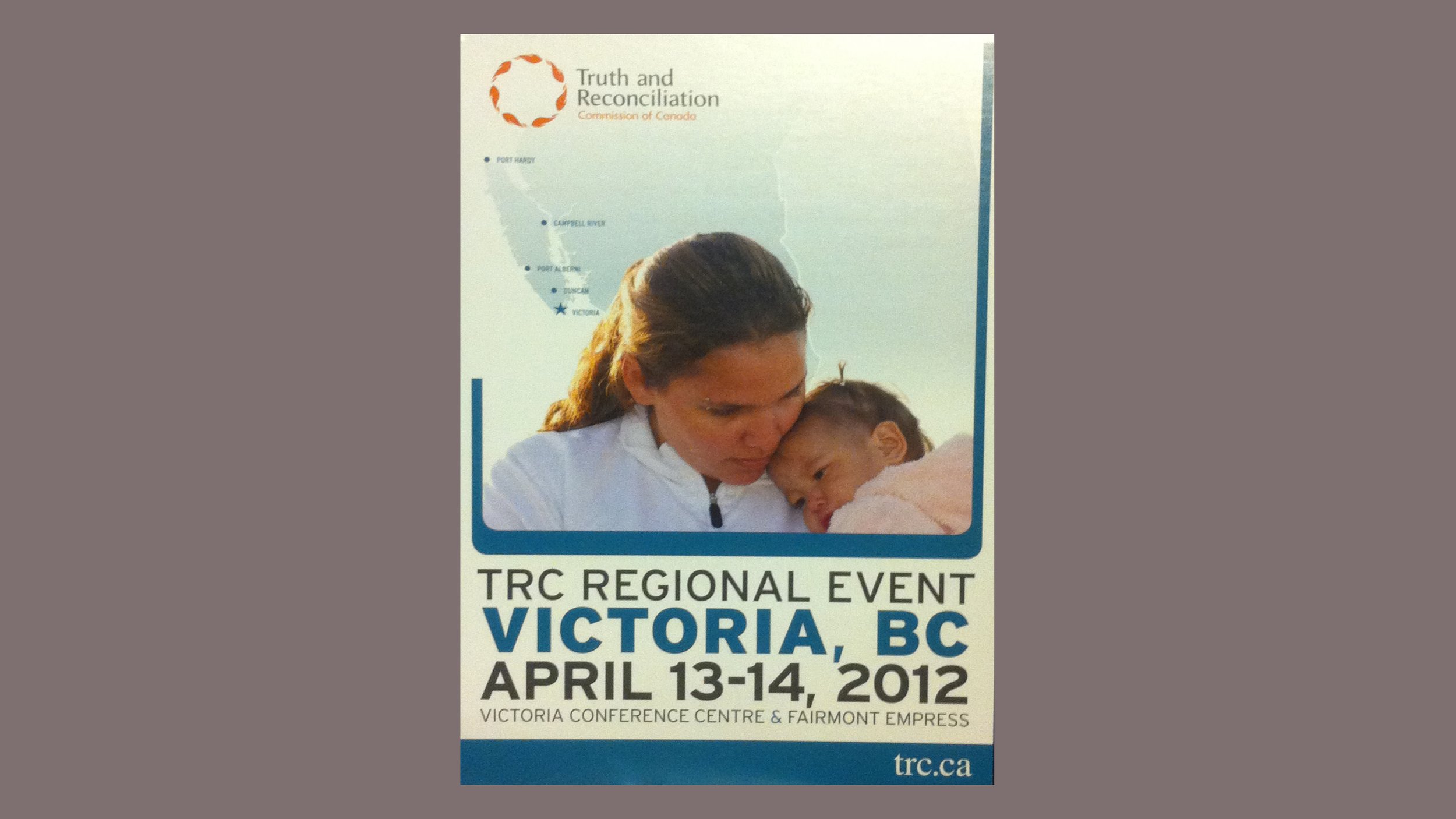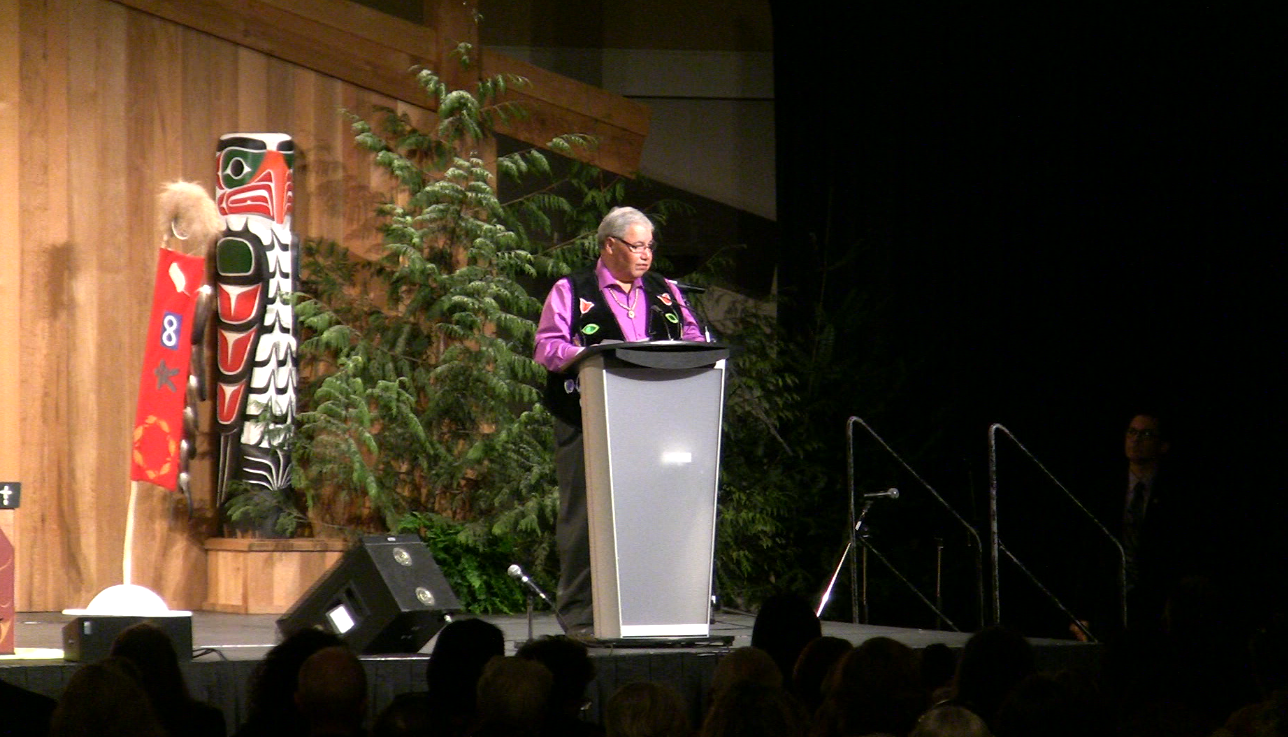
"It Matters to Me"
These four words appear as the slogan on the sleeve of all shirts worn by volunteers and staff members at the Truth and Reconciliation's Regional Conference this past weekend in Victoria BC. And that statement is at the core of the validation that many First Nations people in Canada desperately need. To be heard, to be seen, to be acknowledged is an essential first step toward the process of healing, especially for indigenous people who struggle with issues of identity after generations of being abused, assimilated, and persecuted.
The TRC is helping First Nations people move toward a national awareness and a personal understanding of the crimes they have suffered historically. I want to try to encapsulate my experience at the TRC, not only as a means of trying to gain understanding on a personal level about what I saw there, but also out of a sense of responsibility to the people who courageously testified and shared deep personal pain in a public setting, in hopes that the crimes of the past would be known nationwide, and even worldwide, hopefully to prevent them from ever happening again.
Between 1869 and 1996, the Canadian government, in conjunction with the United Church of Canada, the Anglican Church, The Catholic Church and others, carried out a systematic program of assimilation and cultural annihilation of aboriginal, Inuit, and Métis children by way of the Indian Residential School system, a system of re-education schools that worked to both metaphorically and literally beat the culture, beliefs, and language from First Nations children, effectively forcing them to adopt white culture and customs.
The schools were initially supported by the government because the prevailing idea was that natives who were taught white customs, and who essentially became more white would be less of a financial burden to the government in time as they would integrate more easily into Canadian white society, and would also be less of a threat culturally as white settlers moved west across Canada into the prairies and beyond. Natives supported the idea too.
This was a time of tremendous change in native lifestyles, and many First Nations people, seeing the writing on the wall in terms of encroaching whites, thought that their children would be better prepared to participate in the new society if they were taught to be more effective contributors to the new economy being created and developed by whites..
Unfortunately for the students who were sent by the hundreds of thousands to these schools across Canada, manipulation, greed, and the inclination to dominate on the part of the church officials who ran the schools - the wild card human tendencies at the core of so much corruption - came into play with these institutions. What were concieved as schools to teach natives about white ways quickly became places where racism and brutality ran rampant, with a systemwide focus on destroying the native culture of the students sent to the schools.
Parents were required to send their children. As a result, an entire generation of young First Nations children ended up in church-run schools where they were not allowed to speak their own language, practice any of their own traditions, eat familiar foods, or even keep their hair and were violently punished for doing so. Accounts of sexual assault by priests and nuns were so widespread that some survivors reported nearly 100% assault rates in the schools. There are many documented cases of children having had hat pins driven through their tongues as punishment after speaking their native languages. Children died in droves as well, either at the hands of brutal staff members, from disease, or simply from grief.
There were so many disappearances of children that there is a currently a missing children's program trying to find or even name some of the children who vanished after arriving at the schools, presumedly murdered in the midsts of misconduct on the part of administrators and staff. To not mince words, the Indian Residential Schools were essentially concentration camps for First Nations children.
Our mission was to gain a greater understanding of connections not only between historical genocide and pain, but more recent social crisis and healing, and then determine what we can draw personally from these lessons.
The TRC serves often to have one version of truth shared at the expense of punitive action. In South Africa, the participation was two-way: perpetrators and victims both spoke to their personal experiences. Here in Canada, the experience was largely one-sided, with First Nations people telling stories of what happened to them and whites largely listening (with a few select exceptions from the churches responsible).
So many people have been ignored for so long.
Our trip to Canada in 2012 was focused around the work of the Truth and Reconciliation Commission (TRC). We attended hearings and testimony in Victoria BC under the banner of the TRC. This controversial government body, modeled after previous TRC’s in South Africa and other countries, heard direct testimony from First Nations people in an attempt to gain greater understanding of the crimes committed against generations of Natives in a cultural re-education system that often led to murder, sexual assault, and years-long agony for those involved.
From the Canadian Truth and Reconciliation Final Report:
For over a century, the central goals of Canada’s Aboriginal policy were to eliminate Aboriginal governments; ignore Aboriginal rights; terminate the Treaties; and, through a process of assimilation, cause Aboriginal peoples to cease to exist as dis-tinct legal, social, cultural, religious, and racial entities in Canada. The establishment and operation of residential schools were a central element of this policy, which can best be described as “cultural genocide.”
Physical genocide is the mass killing of the members of a targeted group, and biological genocide is the destruction of the group’s reproductive capacity. Cultural genocide is the destruction of those structures and practices that allow the group to continue as a group. States that engage in cultural genocide set out to destroy the political and social institutions of the targeted group. Land is seized, and populations are forcibly transferred and their movement is restricted. Languages are banned. Spiritual leaders are persecuted, spiritual practices are forbidden, and objects of spiritual value are confiscated and destroyed. And, most significantly to the issue at hand, families are disrupted to prevent the transmission of cultural values and identity from one generation to the next.
In its dealing with Aboriginal people, Canada did all these things.
– – –
For information about the now completed work of the Canadian TRC, please visit the archived website of the TRC.







